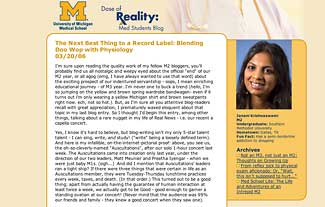Has Jon named his grunge band yet? Where will Okeoma do her residency? Why does Ben think the Clinical Competency Assessment is like the Olympics?

Jon, Okeoma and Ben are among 12 medical students publishing Web journals (called blogs, short for Web logs) on the Medical School Dose of Reality Web site to tell the world what it’s like to go to school at U-M. In particular, they are reaching out to prospective medical students and those who have been accepted but have not yet decided whether to come to the University.
“It’s the little things that can make the difference in where you choose to go to medical school,” says Ben Bryner, who is just completing his second year. “I jot down ideas all the time for topics that I hope will be useful to people considering our school.”
While there are many independent blogs where people post messages about schools, including medical schools, the new Dose of Reality blogs are the only ones sponsored by a U.S. medical school. The site went live in mid-January and can be found at www2.med.umich.edu/medschool/reality.
“We think the blogs will showcase student talent,” says Dr. Dan Remick, assistant dean for admissions and the blog project’s director. “When prospective students see the quality of their potential classmates, we hope the blogs will help convince applicants that a Michigan education is right for them.”
Bloggers post a minimum of one or two messages and photos a month that generally are reflections on how Medical School experiences are shaping them. These first-hand accounts of life at U-M represent unedited, individual thoughts and opinions on topics as wide-ranging as the joys of research, stress, overseas medical missions, snow, clinical rotations and interviewing for residencies.
Remick says initially there were some reservations in administration about the blogging project when it was on the drawing board.
“But when you think about it, we teach professional behavior as part of the medical curriculum and we expect and trust that students will conduct themselves accordingly, he says. “Many of the students have access to all kinds of confidential records, and they maintain the highest level of professionalism with these materials—why would we expect a different kind of behavior on the blogs?”
Remick also conducted a literature review during the blogs’ development and learned that, in general, sponsors don’t need to worry that bloggers will write things that would damage the sponsoring unit’s reputation. While the school sponsors the blogs, no one at the school attempts to regulate, supply or suggest the content.
Bryner agrees the blogs are uncensored, but points out that the blogs are not intended to be a platform for attacking the school.
“I write an accurate representation of what it’s like here,” he says.
Topics he already has covered include:
• Similarities between the Olympics and the Clinical Competency Assessment for second year students;
• Ann Arbor’s most scenic study spots;
• Choosing a specialty.
Topics on the horizon for Bryner’s blog include:
• Extracurricular/advocacy activities and balance in one’s life;
• How his thinking about medicine has changed since pre-med days;
• What the television show ’24’ would be like if adapted to medical students.
Ultimately, it will be the prospective medical students who determine whether the blogs achieve the school’s goals.
Remick says the Admissions Department surveys candidates who choose to come to U-M, as well as those who attend medical school elsewhere. Future surveys will measure awareness of the blogs and whether they impacted the decision on where to go to school.

